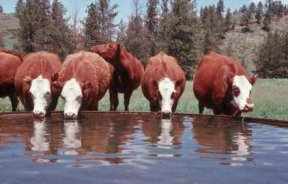Previous Page | Right click this page to print.
Water
Water is the single most important nutrient. In the body, water is the nutrient present in the highest concentration. Water is essential to sustain life and optimal productivity. Water is also the most inexpensive nutrient. All domestic species should have access to an ad-libitum (ad-lib) supply of acceptable quality water. Figure 2.1 illustrates grazing beef cattle consuming water at a supplementary water tank.

Figure 2.2 illustrates the chemical structure of water. Chemically, water is composed of two atoms of hydrogen and one atom of oxygen; denoted H2O. The primary functions of water are to aid in: 1) digestion; 2) nutrient transport; 3) waste excretion; and 4) temperature regulation.

There are three sources of water. The primary source of water is the water consumed by drinking. The second source is the free-water in feedstuffs. Free-water refers to the water present in feedstuffs such as silage. Free-water is not chemically bound to the feed and therefore available to the animal upon consumption. The final source of water is metabolic water. Metabolic water is chemically bound and therefore unavailable prior to metabolic processes.
For the domestic species there are five primary routes for water loss. The routes of water loss include: 1) urine; 2) feces; 3) lungs; 4) skin surface; and 5) milk (for lactating animals).
In addition to water availability, it is important to consider water quality. Water quality influences critical production factors such as feed consumption and animal health. Examples of the more common water contaminants include: dissolved solids, salts, elements and compounds, microorganisms, and algae and protozoa. As water quality can have a significant influence on productivity and profitability and water quality may change over time, it is important to conduct water quality tests on a regular schedule. Recommended testing frequency varies. One component of water quality present to some degree in most water sources is minerals. As well as total mineral content it is important to identify individual minerals present in the water source. Mineral content in the water varies. In addition to considering minerals as a source of water contamination, minerals present in the water source must also be considered when formulating rations. Minerals in the water contribute to the total amount of dietary minerals provided to the animal to meet their dietary requirements.
The dietary water requirement is influenced by a number of factors including, more generally, animal species and physiological state, and more specifically, type of diet consumed and environmental conditions.
Previous Page | Right click this page to print.